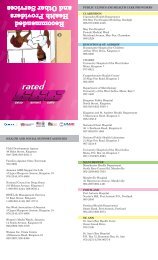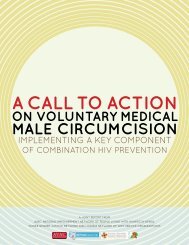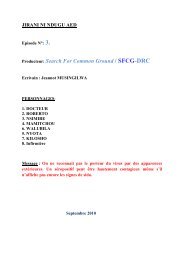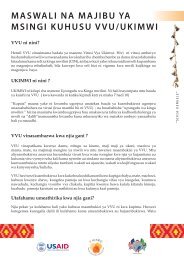module 2 ciblage et conception - C-Hub
module 2 ciblage et conception - C-Hub
module 2 ciblage et conception - C-Hub
You also want an ePaper? Increase the reach of your titles
YUMPU automatically turns print PDFs into web optimized ePapers that Google loves.
MODULE 2 CIBLAGE ET CONCEPTION<br />
Glanz, Karen, Barbara K. Rimer, <strong>et</strong> Sharyn M. Su. 2005. Theory at a glance: A guide for health promotion practice (2 e Édition). Washington : United<br />
States National Cancer Institute.<br />
Glasgow, Russell E., S<strong>et</strong>h Emont, <strong>et</strong> Doriane C. Miller. 2006. Assessing delivery of the five “As” for patient‐centered counseling. Health Promotion<br />
International 21.3: 245‐255.<br />
Goffman, Erving. 1974. Frame analysis: An essay on the organization of experience. New York : Harper & Row.<br />
Gupta, Ge<strong>et</strong>a. 2000. Gender, sexuality, and HIV/AIDS: The what, the why, and the how. Plenary Address at the XIIIth International AIDS Conference<br />
in Affiliation with the International Center for Research on Women (ICRW). Durban, Afrique du Sud, 12 juill<strong>et</strong>.<br />
Holman, Halsted, <strong>et</strong> Kate Lorig. 2000. Patients as partners in managing chronic disease: Partnership is a prerequisite for effective and efficient<br />
health care. British Medical Journal 320.7234: 526‐527.<br />
Iyengar, Shanto. 1991. Is anyone Responsible? How television frames political issues. Chicago : University of Chicago Press.<br />
Jones, Williams K. 1994. A theory of social norms. University of Illinois Law Review 3: 545‐596.<br />
Kahneman, Daniel. 2003. Maps of bounded rationality: Psychology for behavioral economics. The American Economic Review 93.5: 1449‐1475.<br />
King, Rachel. 1999. Sexual behavioural change in HIV: Where have theories taken us? Programme commun des Nations Unies sur le VIH/sida<br />
(ONUSIDA).<br />
Kubisch, Anne, <strong>et</strong> Patricia Auspos. 2004. Building knowledge about community change: Moving beyond evaluations. Washington, DC : Aspen<br />
Institute.<br />
Kubisch, Anne, Patricia Auspos, Prudence Brown, <strong>et</strong> Tom Dewar. 2002. Voices from the field II: Reflections on Comprehensive Community Change.<br />
Washington : Aspen Institute.<br />
Lapinski, Maria Knight, <strong>et</strong> Rajiv Rimal. 2005. An explication of social norms. Communication Theory 15.2: 127‐147.<br />
Lewin, Roger. 2000. Complexity: Life at the edge of chaos. Chicago : University of Chicago Press.<br />
Mackie, Gerry, <strong>et</strong> John Lejeune. 2009. Social dynamics of abandonment of harmful practices: A new look at the Theory. Special series on social<br />
norms and harmful practices: Innocenti Working Paper N° 2009‐06. Florence : Innocenti Research Centre UNICEF.<br />
Maslow, Abraham H. 1943. A theory of human motivation. Psychological Review 50: 370‐396.<br />
MANUEL DU PRATICIEN C‐MODULES : MODULE 2, ANNEXE PAGE 73
















